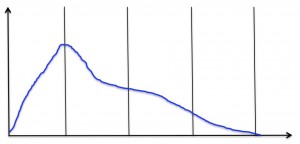The Key Leadership Principle To Creating Lasting Change
We live in a time where the need for strong and effective leaders has never been greater. The failure of basic moral principles permeates every sector of society and unethical behavior by top leaders is almost a daily occurrence.
So I celebrate when business leaders decide to embrace a leadership development program. It’s a sign of hope for a better future, and the best investment into both present and future leaders that pays long-term dividends.
Yet, even with such programs, time and time again we see proven leadership principles ignored when there is an earnings shortfall, a merger or acquisition, a change in top leadership, or a crisis of some kind. It’s as if everything learned is either forgotten or thrown out the window.
It makes we wonder…
- Are leadership development programs a waste of time?
- Are leadership principles only useful during good times?
- Is there something missing to make a lasting impact?
The problem is not the leadership program.
The problem is creating lasting change.
Why Change is Hard
In the late 1990s I did some consulting work with one of the divisions of Franklin Covey. The company came into being when Hyrum Smith merged his company, the creator of the Franklin Planner, with the Covey Leadership Center, founded by Stephen Covey, the best-selling author of The 7 Habits of Highly Effective People. At the time, their leadership programs were considered one of the best in the world.
 However, a common problem uncovered by the analytical folks at Franklin Covey was that lasting change was very difficult to achieve. They had reams of data showing how participants in their various leadership programs initially embraced a change in behavior, but then shortly after the training program reverted back to their old (bad) behaviors.
However, a common problem uncovered by the analytical folks at Franklin Covey was that lasting change was very difficult to achieve. They had reams of data showing how participants in their various leadership programs initially embraced a change in behavior, but then shortly after the training program reverted back to their old (bad) behaviors.
One thing became very clear:
The problem of making leadership principles stick is one of leadership.
A leader who wants lasting change must be a leader who keeps the pressure on.
A Test of Change
A number of years ago I read a powerful leadership book called Lead Like Jesus, written by leadership guru Ken Blanchard and his co-author Phil Hodges (note: a revised version was released April 2016). I was so fascinated by the concepts presented in the book that I became a master trainer of the material.
In one of the exercises at a Leadership Encounter (a 10-hour leadership workshop), participants experience the challenge of creating lasting change.
 In this exercise, participants line up across from a partner (i.e. in an Encounter with 20 people, there are 10 groups of two). Participants are asked to face away from each other and change five things about themselves. Common examples include taking off a shoe, rolling up a shirtsleeve, unbuttoning one button, pulling out an empty pocket, and taking off glasses. When all participants are ready, they turn around to face their partner and take turns identifying what the other person has changed.
In this exercise, participants line up across from a partner (i.e. in an Encounter with 20 people, there are 10 groups of two). Participants are asked to face away from each other and change five things about themselves. Common examples include taking off a shoe, rolling up a shirtsleeve, unbuttoning one button, pulling out an empty pocket, and taking off glasses. When all participants are ready, they turn around to face their partner and take turns identifying what the other person has changed.
This is a fun exercise filled with lots of laughter and smiles – at first.
Then everyone is asked to face away from their partner again and change 5 more things. After some gasps or groans, and then thoughtful creativity, everyone usually manages to accomplish these additional changes.
With a more tired laughter this time, after everyone has identified the additional changes, it’s assumed that the exercise is now done. But when asked to change 5 more things (for a total of 15 changes), almost everyone will loudly complain and look at the facilitator with an expression of “Are you kidding me?!” It’s at this point the exercise is ended and everyone returns to their seats.
As this exercise ends, here’s a list of the comments I often hear:
- That was hard.
- There is no way I could do that.
- That’s impossible.
- No, I’m not going to do it.
- If we kept going I’d soon have nothing on.
Take note. These are the same kind of comments that employees and team members in every organization feel when asked to change, regardless of the type of change.
Change is almost always perceived as unpleasant and difficult.
Key Learning
It’s interesting to see how people respond when asked to change five things. In the exercise they are never told they must take items off or give something up. They could have picked up a pen or other item. They could have changed they way they stand or their facial expression.
It’s human nature to think change always means giving up something.
Yet, change can mean letting go of an unproductive behavior while creating a better habit. It can mean adding a new skill that will propel someone’s career forward.
Here’s the most important learning from the change exercise described above: when the exercise is over, everyone changes back to the way they were at the beginning. No one remains in the new changed state.
When the pressure stops, everyone reverts back to their original state.
This simple exercise explains why so many terrific leadership development programs don’t stick long term. The material and principles taught might be excellent. But without constant pressure from top leadership to maintain the new state, people will revert back to old behaviors – even really bad ones.
Bottom line: To create lasting change, leaders must find ways to keep the pressure on. Without constant pressure, people will always revert back to old behaviors.
———————–
What have you seen that works to create lasting change?









